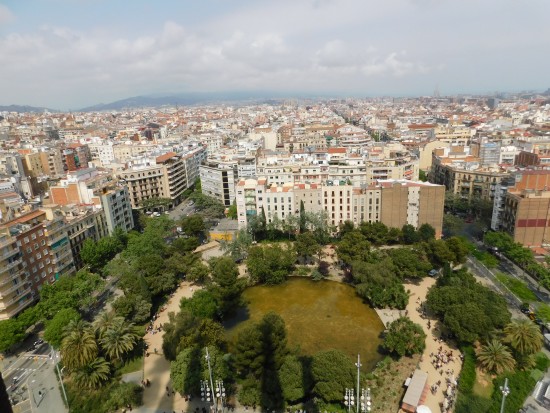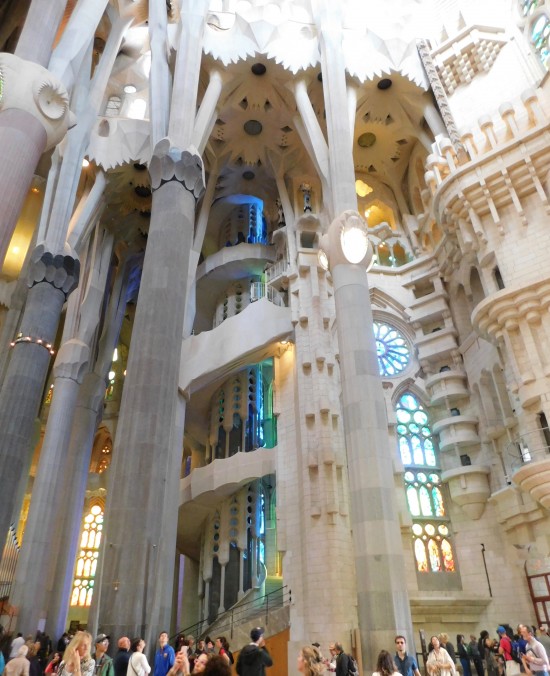What does it mean for a masterpiece to be perennially unfinished? A look at Gaudí’s Sagrada Familia.
A Work in Progress

A masterpiece is classified as a work that displays outstanding artistry, skill, or workmanship. However, not all masterpieces are created equal. Some works of art end up taking much more time to complete than others. One masterpiece whose completion has taken a famously long amount of time is Barcelona’s Sagrada Familia. The church’s completion is scheduled for the year 2026, more than 140 years after construction on the project began. Gaudi, the creative mastermind behind the building’s inception has been famously quoted saying, “My client can wait” in regards to the Sagrada Familia. He thought of his client as God, and wanted his work to be of a caliber that could adequately represent his respect for his deity. While 140 years is a long time to complete a project, it is a drop in the bucket when considering how long it has taken other places of worship to be completed. The Cathedral of St. Michael and St. Gudula in Brussels, Belgium took approximately three-hundred years to complete, and the Notre-Dame Cathedral in Paris took about 185 years to finish. These are time frames that span multiple generations. As I stood in front of these architectural masterpieces this past spring, I wondered: With such long construction periods, how had the integrity of the architect’s vision stayed intact?

Construction on the Sagrada Familia officially began in 1882, but at that point of the building’s inception, Antoni Gaudi had very little to do with the project. The architect in charge at the time was Francisco de Paula del Villar y Lozano. His vision for the Sagrada Familia was to construct a temple in a neo-Gothic style, however, he began to disagree with others on the project and ultimately resigned1. His main contribution to the project was the basilica’s crypt. As I looked upon the entire Sagrada Familia, it was obvious to me that it was far from the typical neo-Gothic church Francisco had in mind. Gaudi took over the project in 1883, at the age of 31, and infused it with his own, very distinct, architectural style[2. “Antoni Gaudí.” Biography.com. A&E Networks Television, 28 June 2016. Web. 13 May 2017.]. This shift in artistic vision is evidenced by how different the crypt of the Sagrada Familia looks from the rest of the church. While the crypt is comforting in the same way a classical black-and-white film provides charm, the basilica is absolutely technicolor. Of course, the vaulted ceilings and Corinthian columns of the crypt are appealing in a traditional sense. As I looked down into the crypt I found comfort in the completed nature of it; the crypt provides a solid foundation for the rest of the basilica, parts of which can be considered a haphazard work in progress.
I am so appreciative that I was able to experience the Sagrada Familia’s vibrant appearance first hand. When I first laid eyes on the Sagrada Familia, I found myself across the street in the appropriately named Plaça de Gaudí. I remember sitting on the brick ledge that overlooks the pond of the park while staring up at Gaudí’s masterpiece. At first glance, the Sagrada Familia seemed far more ornamented than I thought it would be. I even turned to my friend and said, “The Christmas tree smack-dab in the middle seems like a little much.” However, the whole building made a whole lot more sense once I was able to stand right outside the door of the basilica. As I examined the carvings etched into the Nativity façade with my nose pointed towards the sky, I was awestruck with the craftsmanship it must have taken to create all of the story-telling imagery on the building.

Given that I was absolutely floored by the intricacy of the basilica, I grew to really admire Gaudi as the architect behind the project, and I started to think of him as an artist. After researching Gaudi a bit more, what I like the most about him was that he was not afraid to be different. Throughout his lifetime, Gaudi broke with contemporary architectural traditions and introduced a new nature-based style as part of the Catalan Modernista movement. When he first graduated from the Provincial School of Architecture, Gaudi initially followed the traditions of his Victorian predecessors, but as he continued on in his career Gaudi found his own footing in the geometric, patterned, and colorful elements that characterize his constructions. He was also innovative in the structural elements of his designs. His buildings came to be known as equilibrated structures because they could stand on their own without any internal bracing or external buttressing. The approach behind his equilibrated system required creating columns that were tilted in order to create diagonal thrusts and lightweight tile vaults. Gaudi uses this very technique inside the Sagrada Familia. The Sagrada Familia is equilibrated in such a manner that its columns look like tree trunks that separate into ornate branches to create a forest-like internal support for the temple2. In the Spring 2017 semester, I learned a lot about classical architecture in an art history course I took titled “British Art in London.” I learned the differences between Corinthian, Ionic, and other types of columns, but the columns inside the Sagrada Familia were unlike anything I’ve ever seen before. The columns displayed Gaudi’s infatuation with nature and added to the mystical aura the space exuded alongside the sparkling stained-glass windows.

These beautiful tree-like columns did not hold up a solid roof over the entire temple until 2010, almost 130 years after construction on the Sagrada Familia began. It took a very long time for the Sagrada Familia to even be considered functional as a church, and there were many factors that played a role in this delay. At the time of Gaudi’s death in 1926, only the first bell tower on the Nativity facade of the church was completed, but construction on the basilica was able to continue on according to plan thanks to the detailed models Gaudi left behind. Unfortunately, the project came to a halt in 1936 due to the tumultuous nature of the Spanish Civil War. Construction on Sagrada Familia officially resumed in 1939, however, construction on the building occurred slowly for the most part since then due to strikes, funding shortages, and issues uncovering Gaudi’s true vision for Sagrada Familia. During the civil war, some of Gaudi’s models were destroyed in a fire and had to be restored afterward by architect Francesc de Paula Quintana i Vidal. He was able to restore the models to their original design having worked alongside Gaudi back in 1919[4.”History of the Temple.” Sagrada Família. Web. 13 May 2017.].

Due to these setbacks, it was not until the turn of the twenty-first century that construction on the temple really started to pick up. The Sagrada Familia has been able to receive millions more in funding due to an inundation of tourists coming to Barcelona[5. Burgen, Stephen. “Barcelona Cracks down on Tourist Numbers with Accommodation Law.” The Guardian. Guardian News and Media, 27 Jan. 2017. Web. 13 May 2017.]. When considering the exorbitant amount of money it will take to finish building the basilica, the entrance fee I paid of €22.00 seems almost insignificant. Yet, I was still gratified when I thought about how my tiny financial contribution to the basilica will help move the project along. Construction has also started to accelerate since Barcelona-born architect Jordi Fauli took over control of the project in 2012. Fauli was given key pieces of information that helped clear up some of Gaudi’s intentions for Sagrada Familia, thus keeping the initial architect’s vision alive almost a century later. However, admittedly, a visitor can still tell apart new additions to the basilica from the old sections. The weatherbeaten stone of the building looks like it has been through a lot more than the shiny new materials added onto the Sagrada Familia in recent years.

In 2026, disparate parts across centuries, architects, and materials will come together to form the whole Sagrada Familia[6. Tremlett, Giles. “Sagrada Familia Gets Final Completion Date – 2026 or 2028.” The Guardian. Guardian News and Media, 22 Sept. 2011. Web. 13 May 2017.]. I found this structure especially poetic due to the very fact that the Sagrada Familia is still under construction. Multiple generations get to experience the beauty of a masterpiece being built right before their eyes. Tons of visitors come to see the temple every year even though it isn’t finished. The reason why the Sagrada Familia has become an iconic figure in Barcelona’s cityscape is because even though the basilica is unfinished, the building’s carved facade is extremely intricate, while the inside is equally as breathtaking. I found it so comforting that so many people are able to find so much beauty in a work in progress, because at the end of the day, aren’t we all a work in progress? Just as new stone is laid on the project every day, we as people encounter new experiences everyday that hopefully form us into masterpieces in our own right.
Works Cited
“Antoni Gaudí.” Biography.com. A&E Networks Television, 28 June 2016. Web. 13 May 2017.
Burgen, Stephen. “Barcelona Cracks down on Tourist Numbers with Accommodation Law.” The Guardian. Guardian News and Media, 27 Jan. 2017. Web. 13 May 2017.
Collins, George R. “Antonio Gaudi: Structure and Form.” Perspecta 8 (1963): 63. Print.
“History of the Temple.” Sagrada Família. Web. 13 May 2017.
Tremlett, Giles. “Sagrada Familia Gets Final Completion Date – 2026 or 2028.” The Guardian. Guardian News and Media, 22 Sept. 2011. Web. 13 May 2017.
Volner, Ian. “A Completion Date for Sagrada Família, Helped by Technology.” Architect. 23 Jan. 2014. Web. 13 May 2017.